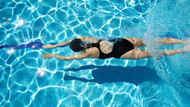Dive into Fitness: Best Ways to Swim for a Healthier You
Published by TE on Jul 3rd 2023
Swimming is not just a recreational activity; it is also an excellent way to achieve your fitness goals. Whether you're looking to shed a few pounds, tone your muscles, or improve your cardiovascular endurance, swimming provides a full-body workout with minimal impact on your joints. In this article, we will explore some of the best ways to swim for fitness purposes, helping you maximize your time in the water and reach new heights of wellness.
- Start with a Warm-Up: Before diving into a rigorous swimming session, it's crucial to warm up your muscles and prepare your body. Begin with some gentle stretches on the pool deck to improve flexibility and reduce the risk of injury. Follow this with a few minutes of easy swimming, gradually increasing your intensity. Warming up helps to elevate your heart rate, increase blood flow to the muscles, and improve your overall performance.
- Mix Up Your Strokes: Swimming offers a variety of strokes that target different muscle groups and provide a well-rounded workout. Experiment with different strokes like freestyle, breaststroke, backstroke, and butterfly. Each stroke engages various muscles, helping you develop strength, endurance, and flexibility. By incorporating a variety of strokes into your routine, you can prevent boredom and work your body in different ways.
- Interval Training: Interval training is an effective way to boost your cardiovascular fitness and burn calories. Alternate between high-intensity and low-intensity swimming periods to challenge your body and keep your workouts interesting. For example, swim at maximum effort for one lap, followed by a leisurely-paced recovery lap. Repeat this pattern for a set duration or a specific number of laps. Interval training not only increases your aerobic capacity but also helps to improve your speed and endurance.
- Incorporate Water Resistance: Take advantage of the natural resistance provided by the water to strengthen your muscles. Consider incorporating water resistance exercises, such as water walking or jogging, into your routine. These activities engage your core, legs, and arms, enhancing muscular endurance and toning your body. You can also use various equipment like kickboards, paddles, or resistance bands to add an extra challenge to your swim workouts.
- Focus on Form and Technique: Proper form and technique are essential for efficient swimming and injury prevention. Work on your body position, breathing, and stroke mechanics to maximize the benefits of each stroke. Consider taking swimming lessons or seeking guidance from a professional swim coach to refine your technique. By improving your form, you can swim more efficiently, conserve energy, and avoid unnecessary strain on your muscles.
- Set Goals and Track Progress: To stay motivated and measure your improvement, set realistic fitness goals and track your progress. Whether it's swimming a certain distance, reducing your lap times, or increasing the number of laps you can complete, having tangible targets helps you stay focused and driven. Consider using a fitness tracker or keeping a swim log to record your workouts, distances, and times. Celebrate your achievements, no matter how small, as they serve as stepping stones towards a fitter and healthier you.
Swimming is a highly rewarding exercise that offers numerous benefits for your overall fitness. By incorporating these best practices into your swimming routine, you can enhance your cardiovascular health, build strength, improve flexibility, and achieve your fitness goals. Remember to start slowly, listen to your body, and gradually increase the intensity and duration of your swims. So, dive in, embrace the water, and enjoy the journey to a healthier, fitter you!

